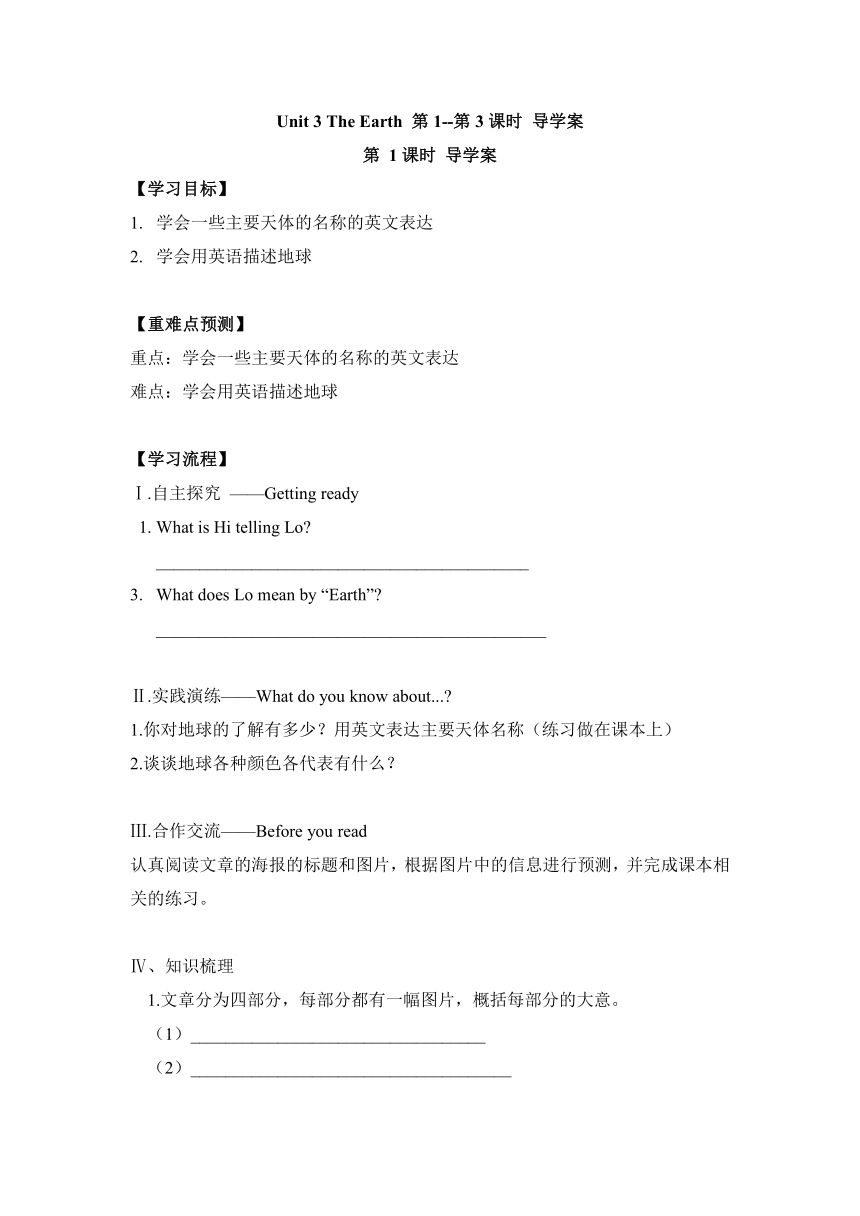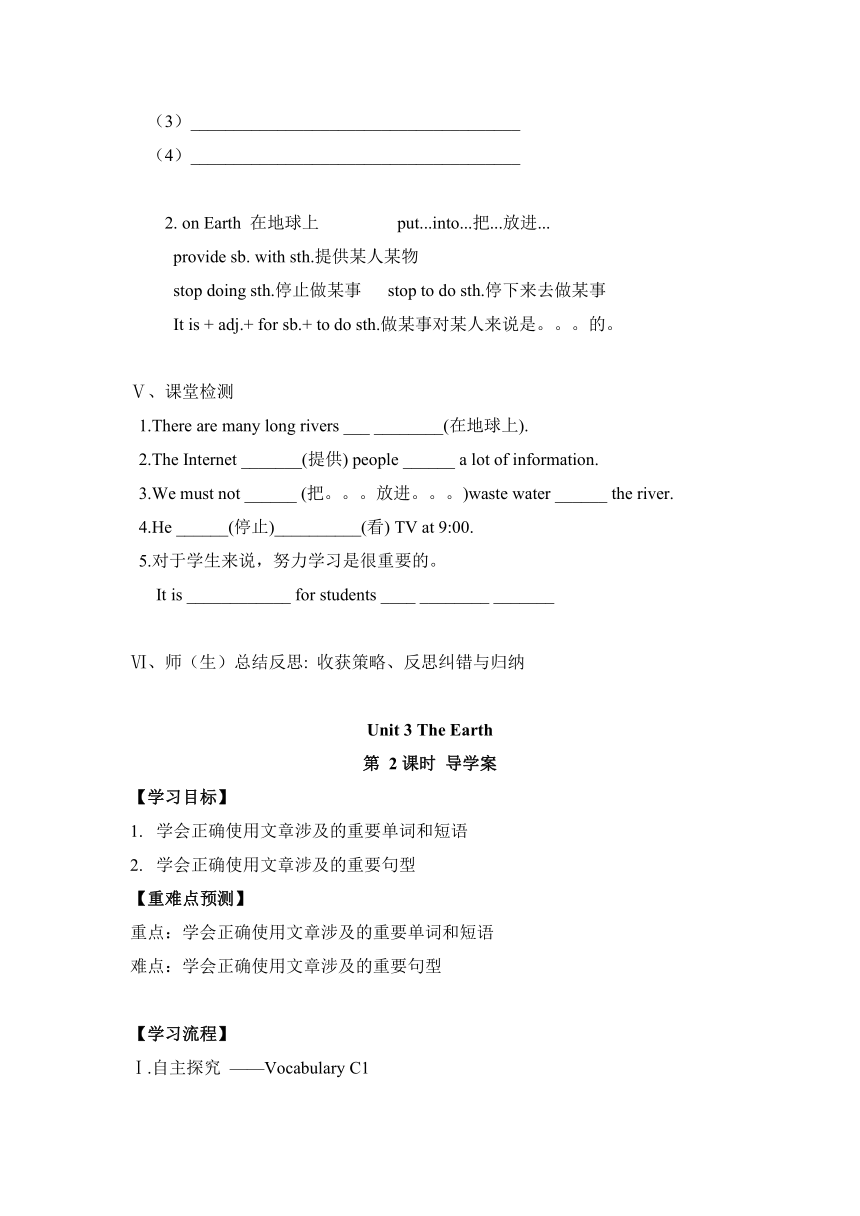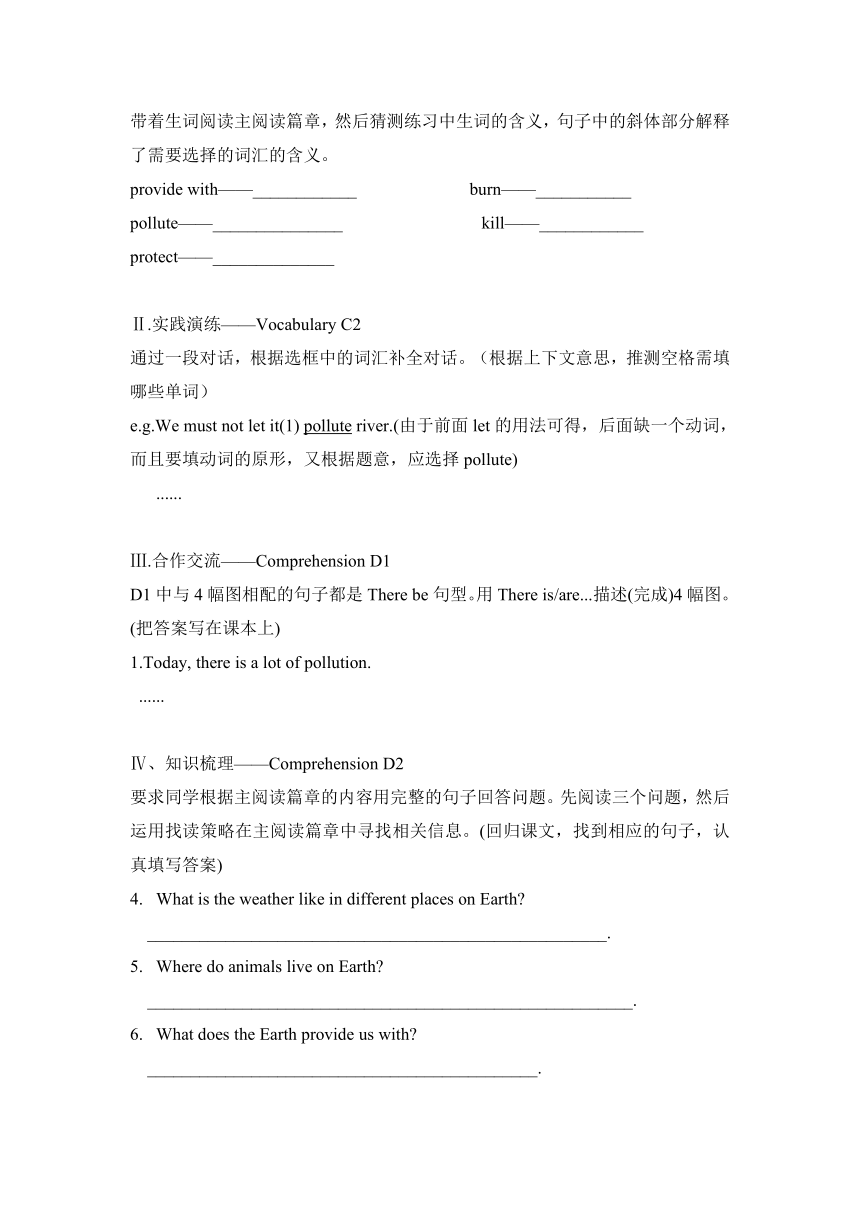牛津深圳版七上:Unit 3 the earth. 1-3课时 导学案(无答案)
文档属性
| 名称 | 牛津深圳版七上:Unit 3 the earth. 1-3课时 导学案(无答案) |  | |
| 格式 | doc | ||
| 文件大小 | 39.5KB | ||
| 资源类型 | 教案 | ||
| 版本资源 | 牛津深圳版 | ||
| 科目 | 英语 | ||
| 更新时间 | 2021-04-16 17:04:32 | ||
图片预览



文档简介
Unit 3 The Earth 第1--第3课时 导学案
第 1课时 导学案
【学习目标】
学会一些主要天体的名称的英文表达
学会用英语描述地球
【重难点预测】
重点:学会一些主要天体的名称的英文表达
难点:学会用英语描述地球
【学习流程】
Ⅰ.自主探究 ——Getting ready
1. What is Hi telling Lo?
___________________________________________
What does Lo mean by “Earth”?
_____________________________________________
Ⅱ.实践演练——What do you know about...?
你对地球的了解有多少?用英文表达主要天体名称(练习做在课本上)
谈谈地球各种颜色各代表有什么?
Ⅲ.合作交流——Before you read
认真阅读文章的海报的标题和图片,根据图片中的信息进行预测,并完成课本相关的练习。
Ⅳ、知识梳理
1.文章分为四部分,每部分都有一幅图片,概括每部分的大意。
(1)__________________________________
(2)_____________________________________
(3)______________________________________
(4)______________________________________
2. on Earth 在地球上 put...into...把...放进...
provide sb. with sth.提供某人某物
stop doing sth.停止做某事 stop to do sth.停下来去做某事
It is + adj.+ for sb.+ to do sth.做某事对某人来说是。。。的。
Ⅴ、课堂检测
1.There are many long rivers ___ ________(在地球上).
2.The Internet _______(提供) people ______ a lot of information.
3.We must not ______ (把。。。放进。。。)waste water ______ the river.
4.He ______(停止)__________(看) TV at 9:00.
5.对于学生来说,努力学习是很重要的。
It is ____________ for students ____ ________ _______
Ⅵ、师(生)总结反思: 收获策略、反思纠错与归纳
Unit 3 The Earth
第 2课时 导学案
【学习目标】
学会正确使用文章涉及的重要单词和短语
学会正确使用文章涉及的重要句型
【重难点预测】
重点:学会正确使用文章涉及的重要单词和短语
难点:学会正确使用文章涉及的重要句型
【学习流程】
Ⅰ.自主探究 ——Vocabulary C1
带着生词阅读主阅读篇章,然后猜测练习中生词的含义,句子中的斜体部分解释了需要选择的词汇的含义。
provide with——____________ burn——___________
pollute——_______________ kill——____________
protect——______________
Ⅱ.实践演练——Vocabulary C2
通过一段对话,根据选框中的词汇补全对话。(根据上下文意思,推测空格需填哪些单词)
e.g.We must not let it(1) pollute river.(由于前面let的用法可得,后面缺一个动词,而且要填动词的原形,又根据题意,应选择pollute)
......
Ⅲ.合作交流——Comprehension D1
D1中与4幅图相配的句子都是There be句型。用There is/are...描述(完成)4幅图。(把答案写在课本上)
Today, there is a lot of pollution.
......
Ⅳ、知识梳理——Comprehension D2
要求同学根据主阅读篇章的内容用完整的句子回答问题。先阅读三个问题,然后运用找读策略在主阅读篇章中寻找相关信息。(回归课文,找到相应的句子,认真填写答案)
What is the weather like in different places on Earth?
_____________________________________________________.
Where do animals live on Earth?
________________________________________________________.
What does the Earth provide us with?
_____________________________________________.
Ⅴ、课堂检测——Comprehension D3
关于地球,你还了解它目前面临哪些问题?
There is/are ...
Some...Some...
Ⅵ、师(生)总结反思: 收获策略、反思纠错与归纳
Unit 3 The Earth
第3课时 导学案
学习目标:了解名词的基础分类
掌握可数名词的复数形式的变化规则
区分可数名词和不可数名词,并完成相应的习题
学习难点:可数名词与不可数名词的区分以及完成习题
学习过程:
一、可数名词与不可数名词的分类归纳
an apple apples grass
a banana bananas rubbish
a river rivers air
a flower flowers water
可数名词:
不可数名词:
举例:
二、可数名词
可数名词具有 和 两种形态。指一个人或一个事物时,用 ;指两个人或多个人或者多个事物时,用 。
可数名词单复数的变化规则:
1).一般的名词词尾直接加-s:
book---books room---rooms
举例:
2).以-s, -ss, -ch, -sh, -x结尾的名词,加-es
bus---buses glass---glasses
watch---watches dish---dishes box-boxes
举例:
3).以“辅音字母+y”结尾的名词,改y为i加-es
city---cities body---bodies factory---factories
举例:
4).以-f或-fe结尾的名词,要将f或fe改为v加-es
half-halves leaf---leaves
举例:
5).特例:
child man woman
policeman tomato potato
foot tooth
sheep, Chinese, Japanese 这几个单词,单数与复数同形。
三、不可数名词
不可数名词没有复数形式,当不可数名词作主语时,谓语动词用
如:
The food is very fresh.
四、观察下列句子,区分可数名词与不可数名词的谓语动词的形态规则
The earth is a beautiful place.
There are forests, and rivers, mountains and fields.
Air is important.
I have an egg and a piece of bread for breakfast.
This plant is beautiful.
These animals are dangerous.
Air has no smell.
归纳总结:
1.
2.
3.
4.
五、习题巩固
根据括号中所给的名词,用名词的正确形式填空。
Tom has three ( egg )and a piece of bread for breakfast.
The moon is cold (place).
根据划横线的名词和括号中所给的动词,用动词的正确形式填空。
Water ( be )important.
Water ( have) no smell.
六、拓展:
many much
how many how much
许多苹果
许多水
天上有多少星星?
stars are there in the sky?
杯子里面有多少牛奶?
milk are there in the glass?
第 1课时 导学案
【学习目标】
学会一些主要天体的名称的英文表达
学会用英语描述地球
【重难点预测】
重点:学会一些主要天体的名称的英文表达
难点:学会用英语描述地球
【学习流程】
Ⅰ.自主探究 ——Getting ready
1. What is Hi telling Lo?
___________________________________________
What does Lo mean by “Earth”?
_____________________________________________
Ⅱ.实践演练——What do you know about...?
你对地球的了解有多少?用英文表达主要天体名称(练习做在课本上)
谈谈地球各种颜色各代表有什么?
Ⅲ.合作交流——Before you read
认真阅读文章的海报的标题和图片,根据图片中的信息进行预测,并完成课本相关的练习。
Ⅳ、知识梳理
1.文章分为四部分,每部分都有一幅图片,概括每部分的大意。
(1)__________________________________
(2)_____________________________________
(3)______________________________________
(4)______________________________________
2. on Earth 在地球上 put...into...把...放进...
provide sb. with sth.提供某人某物
stop doing sth.停止做某事 stop to do sth.停下来去做某事
It is + adj.+ for sb.+ to do sth.做某事对某人来说是。。。的。
Ⅴ、课堂检测
1.There are many long rivers ___ ________(在地球上).
2.The Internet _______(提供) people ______ a lot of information.
3.We must not ______ (把。。。放进。。。)waste water ______ the river.
4.He ______(停止)__________(看) TV at 9:00.
5.对于学生来说,努力学习是很重要的。
It is ____________ for students ____ ________ _______
Ⅵ、师(生)总结反思: 收获策略、反思纠错与归纳
Unit 3 The Earth
第 2课时 导学案
【学习目标】
学会正确使用文章涉及的重要单词和短语
学会正确使用文章涉及的重要句型
【重难点预测】
重点:学会正确使用文章涉及的重要单词和短语
难点:学会正确使用文章涉及的重要句型
【学习流程】
Ⅰ.自主探究 ——Vocabulary C1
带着生词阅读主阅读篇章,然后猜测练习中生词的含义,句子中的斜体部分解释了需要选择的词汇的含义。
provide with——____________ burn——___________
pollute——_______________ kill——____________
protect——______________
Ⅱ.实践演练——Vocabulary C2
通过一段对话,根据选框中的词汇补全对话。(根据上下文意思,推测空格需填哪些单词)
e.g.We must not let it(1) pollute river.(由于前面let的用法可得,后面缺一个动词,而且要填动词的原形,又根据题意,应选择pollute)
......
Ⅲ.合作交流——Comprehension D1
D1中与4幅图相配的句子都是There be句型。用There is/are...描述(完成)4幅图。(把答案写在课本上)
Today, there is a lot of pollution.
......
Ⅳ、知识梳理——Comprehension D2
要求同学根据主阅读篇章的内容用完整的句子回答问题。先阅读三个问题,然后运用找读策略在主阅读篇章中寻找相关信息。(回归课文,找到相应的句子,认真填写答案)
What is the weather like in different places on Earth?
_____________________________________________________.
Where do animals live on Earth?
________________________________________________________.
What does the Earth provide us with?
_____________________________________________.
Ⅴ、课堂检测——Comprehension D3
关于地球,你还了解它目前面临哪些问题?
There is/are ...
Some...Some...
Ⅵ、师(生)总结反思: 收获策略、反思纠错与归纳
Unit 3 The Earth
第3课时 导学案
学习目标:了解名词的基础分类
掌握可数名词的复数形式的变化规则
区分可数名词和不可数名词,并完成相应的习题
学习难点:可数名词与不可数名词的区分以及完成习题
学习过程:
一、可数名词与不可数名词的分类归纳
an apple apples grass
a banana bananas rubbish
a river rivers air
a flower flowers water
可数名词:
不可数名词:
举例:
二、可数名词
可数名词具有 和 两种形态。指一个人或一个事物时,用 ;指两个人或多个人或者多个事物时,用 。
可数名词单复数的变化规则:
1).一般的名词词尾直接加-s:
book---books room---rooms
举例:
2).以-s, -ss, -ch, -sh, -x结尾的名词,加-es
bus---buses glass---glasses
watch---watches dish---dishes box-boxes
举例:
3).以“辅音字母+y”结尾的名词,改y为i加-es
city---cities body---bodies factory---factories
举例:
4).以-f或-fe结尾的名词,要将f或fe改为v加-es
half-halves leaf---leaves
举例:
5).特例:
child man woman
policeman tomato potato
foot tooth
sheep, Chinese, Japanese 这几个单词,单数与复数同形。
三、不可数名词
不可数名词没有复数形式,当不可数名词作主语时,谓语动词用
如:
The food is very fresh.
四、观察下列句子,区分可数名词与不可数名词的谓语动词的形态规则
The earth is a beautiful place.
There are forests, and rivers, mountains and fields.
Air is important.
I have an egg and a piece of bread for breakfast.
This plant is beautiful.
These animals are dangerous.
Air has no smell.
归纳总结:
1.
2.
3.
4.
五、习题巩固
根据括号中所给的名词,用名词的正确形式填空。
Tom has three ( egg )and a piece of bread for breakfast.
The moon is cold (place).
根据划横线的名词和括号中所给的动词,用动词的正确形式填空。
Water ( be )important.
Water ( have) no smell.
六、拓展:
many much
how many how much
许多苹果
许多水
天上有多少星星?
stars are there in the sky?
杯子里面有多少牛奶?
milk are there in the glass?
